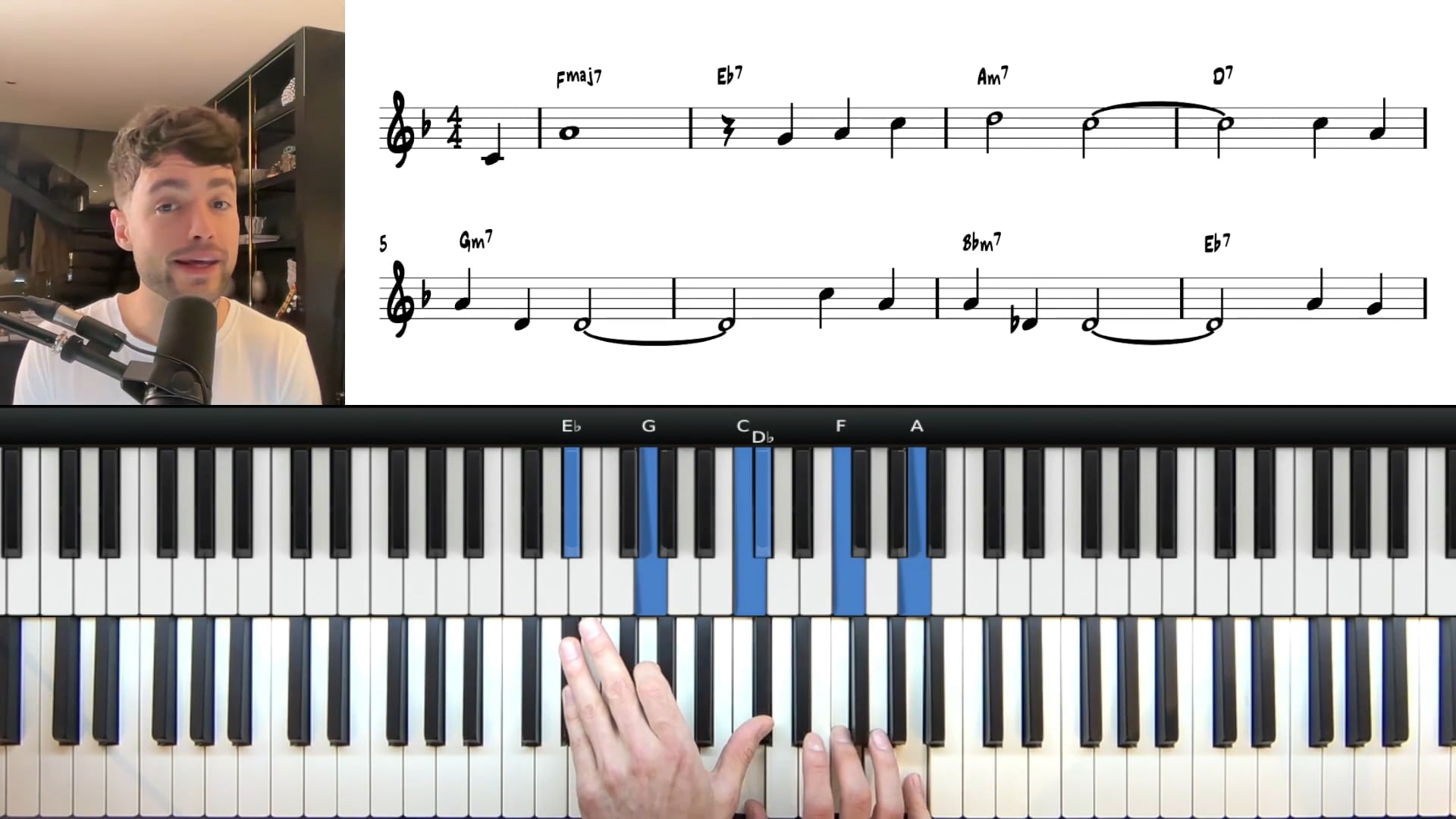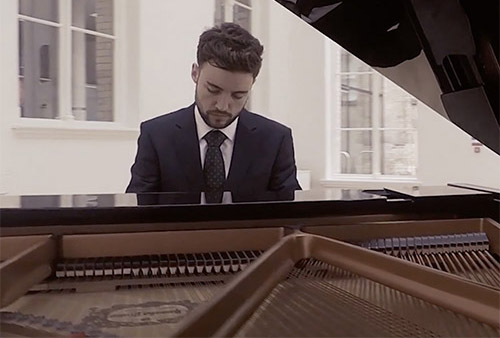

Hayden Hill
Hayden founded PianoGroove in 2015 with the goal of making the world a more musical place. He shares his love for jazz piano through his online courses and manages the community area of PianoGroove.
Live Seminar Resources
Live Seminar Resources
PDF Downloads
- The Days Of Wine & Roses - Chord Chart
Join PianoGroove Pro to access all downloads and learning resources.
Download theory supplements, midi files, chord changes and full note-for-note transcriptions of every lesson.
- UST Cheat Sheet
Join PianoGroove Pro to access all downloads and learning resources.
Download theory supplements, midi files, chord changes and full note-for-note transcriptions of every lesson.
Related Lessons
Forum Threads
Seminar Description
Seminar Description
Upper Structure Triads in "The Days of Wine and Roses"
Welcome to this in-depth seminar on upper structure triads, using the jazz standard "The Days of Wine and Roses" as our study piece. This lesson is designed for intermediate jazz pianists looking to enrich their harmonic vocabulary by incorporating upper structure triads into their voicings.
By the end of this lesson, you’ll have a strong grasp of how to apply upper structure triads to dominant chords, create more sophisticated harmonies, and seamlessly integrate these sounds into your jazz playing.
Understanding Upper Structure Triads
Upper structure triads are a powerful technique used by jazz pianists to create color and texture over dominant chords. They involve playing a triad in the right hand while outlining the dominant shell in the left hand.
A key takeaway from this lesson is that upper structure triads sound best in second inversion. This inversion places the root of the triad in the middle, creating a balanced and resonant voicing.
Applying Upper Structures to "The Days of Wine and Roses"
In this lesson, we break down the main chord changes of the tune, analyzing where upper structure triads can be used to enhance the harmonic movement.
- Over Eb7, we use an F major triad to highlight the 9th, sharp 11th, and 13th.
- For D7, we apply a Bb major triad to create a D7#5#9 sound.
- In the B section, we explore using upper structures over C7 and G7, ensuring smooth voice leading and effective melody harmonization.
We also discuss how sus chords and passing chords can be integrated with upper structures to create rich harmonic movement.
The Importance of Melody Integration
One of the challenges with upper structure triads is aligning them with the melody. In this lesson, we focus on cases where the root, 11th, or 13th is in the melody, and we explore different options for harmonizing these notes effectively.
A key takeaway is that when the 11th is in the melody over a minor chord, it creates a perfect opportunity to transition into an upper structure triad on the following dominant chord.
Adding Passing Chords & Substitutions
To create fluid harmonic movement, we introduce passing chords and tritone substitutions. By inserting dominant chords a half-step above the target chord, we add sophisticated tension and resolution.
For example:
- In the transition from A-7 to D-7, we insert an Eb7 (tritone sub passing chords) voiced with an F major upper structure triad.
- This technique adds unexpected harmonic colors while maintaining a strong sense of motion in the arrangement.
Practice Tips
-
UST Formulas – Memorize the four key upper structure triads. These are major triads built on the 9th, sharp 11th, sharp 5th, and 13th.
-
USTs to Harmonize Melodies – Analyze lead sheets and identify step wise melodies where UST voicings can be used to harmonize the melody notes.
-
Experiment with Passing Chords – Add dominant chords a half-step above your target chord and try to harmonise the melody note with an UST.
- Listen to the Voicings in Context – Play through "The Days of Wine and Roses" and listen to how upper structures enhance the sound of the arrangement.
By incorporating these concepts into your playing, you’ll develop a richer harmonic vocabulary and be able to approach jazz standards with greater confidence and creativity.
Keep practicing and experimenting with these voicings, and soon they will become a natural part of your jazz piano toolkit!








Hi Hayden, was a victim of the tech glitch during the ‘live’ version and so happy to go through the recorded one. I am a beginner and have the following questions
1) To get fluency, should I practice using the cheat sheet in all keys ?
2) When you say that the 2nd inversion is the best sounding inversion, does it mean we should not use the other inversions ?
3) Would you consider to always end a song using the UST ?
4) Are the UST related to the different modes ? Are each of your 4 different variations of UST in your cheat sheet related to different modes ?
Thanks, Arun
Hi Aaron,
My apologies for the tech glitch during this seminar. I have implemented a new live stream system that we will use on Wednesday, so there will be no further technical issues. Thank you for your understanding.
To answer your questions:
1) To get fluency, should I practice using the cheat sheet in all keys ?
I recommend using the cheat sheet when playing through jazz standards. Instead of using the cheat sheet to work through all 12 keys, simply find dominant chords when playing through jazz standards and then use the cheat sheet to follow the process that I outlined in the first seminar this month. Before long, you will have encountered all 12 dominant chords in the jazz standards that you are playing. I find this way to be a much more practical and effective way to learn how to use upper structure triads, as otherwise it can be quite overwhelming to try to work through all 12 keys as a practice exercise, as at the end of this one can still be unsure how to apply the chords to out playing.
The process I outline will help you to learn the theory, but most importantly we are always applying it to songs and standards so that we understand how to actually use these chords and voicings in the songs that we are playing – which is the end goal!
2) When you say that the 2nd inversion is the best sounding inversion, does it mean we should not use the other inversions ?
Yes I mentioned the second inversion is the best sounding inversion but that doesn’t mean that we should only use the second inversion. Ultimately, we use upper structure triads to harmonize the melody notes on lead sheets. One part of the process is to find the correct inversion that keeps the melody note intact. I was simply saying that the second inversion has the strongest sound, and so perhaps if you had a choice between two different inversions or two different upper structures, this could help you to choose the most suitable voicing. In the final seminar this month we will dive a little bit deeper into the inversions and tritone substitution.
3) Would you consider to always end a song using the UST ?
I would not consider to always end a song using an upper structure triad, however, it is something that we can do. This also works well at the end of repeating sections where we often have space in the turnaround section. We will go into more detail with fills and upper structure triad runs in this week’s seminar and I’ll show you some fills and runs that I use all the time in my playing.
4) Are the UST related to the different modes ? Are each of your 4 different variations of UST in your cheat sheet related to different modes ?
Yes, upper structures can be related to different modes. This is a good point for discussion in this week’s seminar. Whilst it is useful to have an understanding of modes, I personally try to think more in terms of chord tones and chord structures (such as triads) than purely thinking about scales. Whilst scales can be used in improvisation, I find that by thinking in terms of chord tones and also chord structures such as triads, it gives a much more balanced sound than thinking purely in terms of scales.
Thank you for these great questions Arun – I will be sure to expand upon them in the upcoming seminars.
If you have any other questions, please post them here, and I’m happy to assist further.
Talk soon,
Hayden
Yes, this is very useful, great to see the replay. There is quite a bit of trial and error in coming up with voicings, at least for me at my stage, but the “trials” provide a great review of jazz fundamentals, as you said. Plus it is fun. Looking forward to remaining seminars on USTs.